The Dog Vaccine Market is estimated to be valued at USD 2.0 billion in 2025 and is projected to reach USD 3.5 billion by 2035, registering a compound annual growth rate (CAGR) of 5.8% over the forecast period. Between 2025 and 2030, the market is expected to rise from USD 2.0 billion to USD 2.7 billion, driven by increasing pet ownership and growing awareness of preventive healthcare for pets.
Year-on-year analysis shows steady growth, with values reaching USD 2.1 billion in 2026 and USD 2.3 billion in 2027, supported by rising veterinary visits and advancements in vaccine development for common canine diseases. By 2028, the market is forecasted to hit USD 2.4 billion, progressing to USD 2.5 billion in 2029 and USD 2.7 billion by 2030.
Growth will be further fueled by innovations in vaccine formulations, including combination vaccines and those targeting emerging infectious diseases. Increasing focus on global veterinary care standards and regulatory support for pet health initiatives will also drive market expansion. These dynamics position the dog vaccine market as a crucial segment within the broader animal healthcare industry, supporting pet wellness and public health.
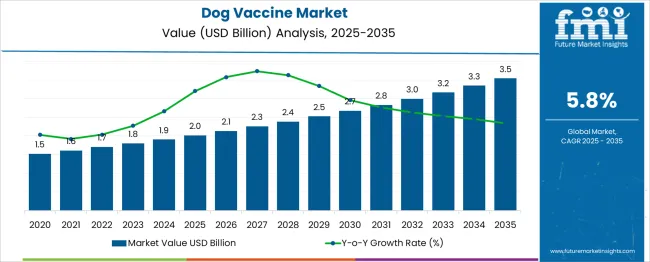
| Metric | Value |
|---|---|
| Dog Vaccine Market Estimated Value in (2025 E) | USD 2.0 billion |
| Dog Vaccine Market Forecast Value in (2035 F) | USD 3.5 billion |
| Forecast CAGR (2025 to 2035) | 5.8% |
The Dog Vaccine market is experiencing steady growth, driven by increasing pet ownership, rising awareness about canine health, and growing emphasis on preventive veterinary care. As highlighted in industry news and veterinary association publications, the need to curb the prevalence of contagious and potentially fatal diseases in dogs has spurred demand for effective vaccination programs.
The current market scenario is marked by greater accessibility to veterinary services, improved supply chain networks, and a growing willingness among pet owners to invest in canine health. Regulatory guidelines advocating routine immunization and initiatives by animal welfare organizations have further supported the uptake of vaccines.
The future outlook remains promising as innovations in vaccine technology, such as DNA-based vaccines and combination immunizations, are expected to broaden the spectrum of protection and enhance efficacy. Veterinary healthcare providers and manufacturers are also focusing on sustainability and affordability to ensure continued growth across both developed and emerging markets.
The dog vaccine market is segmented by vaccine type, disease type, route of administration, end-use, and geographic regions. By vaccine type, the dog vaccine market is divided into Live attenuated, Inactivated, Recombinant, and Other vaccine types. In terms of disease type, the dog vaccine market is classified into Canine distemper, Canine infectious respiratory disease complex (CIRDC), Canine parvovirus, Canine leptospirosis, Canine lyme disease, Infectious canine hepatitis, Canine rabies, and other disease types.
Based on the route of administration, the dog vaccine market is segmented into Injectable, Intranasal, and Oral. The end-use of the dog vaccine market is segmented into Veterinary hospitals, Veterinary clinics, and Research institutes. Regionally, the dog vaccine industry is classified into North America, Latin America, Western Europe, Eastern Europe, Balkan & Baltic Countries, Russia & Belarus, Central Asia, East Asia, South Asia & Pacific, and the Middle East & Africa.
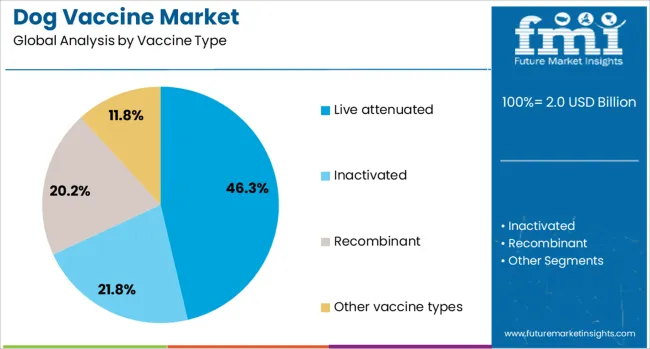
The live attenuated vaccine type is expected to hold 46.3% of the Dog Vaccine market revenue share in 2025, making it the leading vaccine type segment. This dominance is being attributed to its proven efficacy in inducing strong and long-lasting immunity in dogs, as observed in veterinary clinical studies and product announcements.
Live attenuated vaccines have been preferred by veterinary professionals due to their ability to closely mimic natural infections, thereby offering better protection against prevalent diseases. Their widespread adoption has also been supported by cost-effectiveness and ease of production compared to newer vaccine types.
Industry journals have noted that the segment benefits from extensive research data and established regulatory approvals, which facilitate trust and widespread use among veterinarians and pet owners. The continued reliance on this vaccine type has been reinforced by its capacity to provide a rapid and robust immunological response, ensuring it remains a cornerstone of canine vaccination protocols globally.
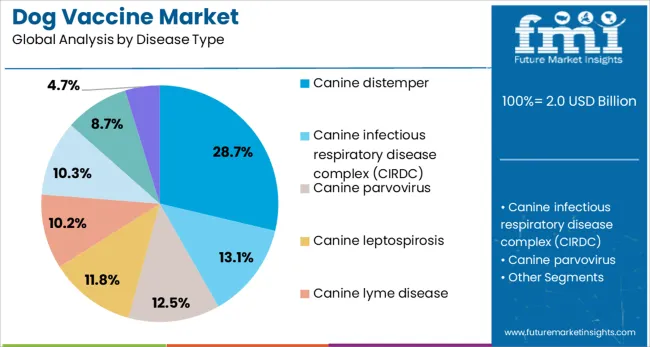
The canine distemper disease type is projected to account for 28.7% of the Dog Vaccine market revenue share in 2025, establishing it as the leading disease type segment. This leadership is being driven by the high incidence and severe nature of canine distemper, which remains a major health threat in dogs, as documented by veterinary health organizations and animal welfare agencies. The disease’s highly contagious and often fatal outcomes have prompted consistent demand for effective immunization solutions.
Veterinary publications have highlighted that the inclusion of distemper vaccines in core vaccination schedules has reinforced their prominence. Additionally, increased awareness campaigns and government-supported vaccination drives have contributed to maintaining high uptake.
The ability of the vaccine to significantly reduce mortality and morbidity rates, alongside its integration in combination vaccines, has strengthened its role in preventive veterinary medicine. These factors have ensured that the canine distemper segment continues to dominate the market with a strong share in 2025.
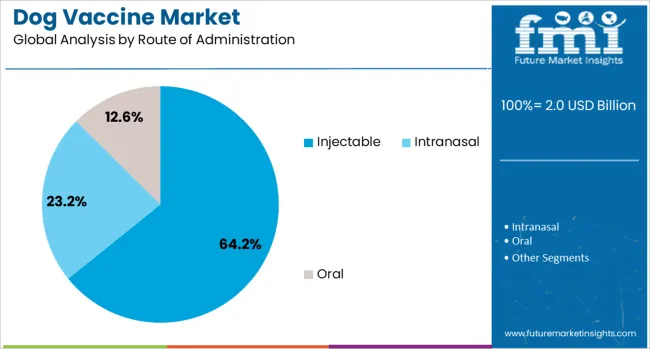
The injectable route of administration is anticipated to capture 64.2% of the Dog Vaccine market revenue share in 2025, sustaining its position as the largest segment by administration route. This dominance has been influenced by its established efficacy, precision in dosage delivery, and widespread acceptance among veterinary professionals, as noted in veterinary practice guidelines and industry news releases. Injectable vaccines have been favored for their ability to provide consistent and predictable immune responses, which are critical for effective disease prevention.
Veterinary journals have emphasized that injectables offer reliable protection against multiple diseases when administered according to standardized protocols. Furthermore, the robust supply infrastructure and existing training of veterinary staff in injectable administration have supported its widespread adoption.
The segment’s strength has also been reinforced by its compatibility with combination vaccines and minimal requirement for specialized equipment, ensuring accessibility even in resource-limited settings. These advantages have cemented the injectable route’s leadership in the Dog Vaccine market.
The dog vaccine market is driven by the increasing awareness of pet health and growing demand for preventative care. Key growth drivers include rising pet ownership and concerns about zoonotic diseases. Opportunities lie in emerging markets and expanding vaccine portfolios. Emerging trends include the development of combination vaccines and new delivery methods. However, market restraints include high vaccine costs and challenges with regulatory approvals, especially in developing countries, which could impede market expansion.
The major growth driver in the dog vaccine market is the increasing number of pet owners globally. In 2024, the growing trend of pet adoption, particularly in urban areas, increased demand for pet healthcare products. This trend is expected to continue into 2025, with a focus on providing pets with preventive measures, such as vaccines, to safeguard their health. The rising awareness among owners regarding the importance of vaccines contributes significantly to this market's expansion.
Opportunities in the dog vaccine market are driven by the growing demand for vaccines in emerging markets. In 2024, developing regions, particularly in Asia-Pacific and Latin America, saw increased pet adoption, creating a significant need for veterinary healthcare. Additionally, the expansion of vaccine portfolios to address various diseases in pets is expected to drive market growth. By 2025, the availability of more region-specific vaccines will further support market opportunities.
Emerging trends in the dog vaccine market include the development of combination vaccines and alternative delivery methods. Combination vaccines, which address multiple diseases with a single injection, are expected to increase in popularity by 2025 due to their convenience and cost-effectiveness. Additionally, advancements in oral vaccines and non-injection delivery methods are gaining traction, as they reduce the stress and discomfort for pets, contributing to higher vaccine compliance.
Major restraints in the dog vaccine market include high vaccine costs and challenges with regulatory approvals. In 2024, many pet owners found the cost of vaccines to be prohibitive, especially for comprehensive vaccination schedules. Furthermore, regulatory hurdles in some regions, especially in emerging markets, delay the availability of new vaccines. These barriers are expected to continue impacting market growth, particularly in price-sensitive regions, through 2025.
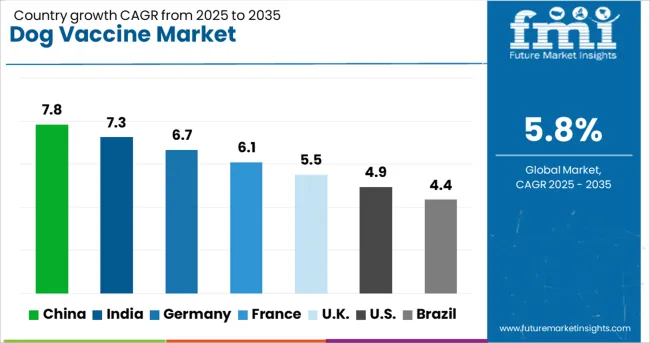
| Country | CAGR |
|---|---|
| China | 7.8% |
| India | 7.3% |
| Germany | 6.7% |
| France | 6.1% |
| UK | 5.5% |
| USA | 4.9% |
| Brazil | 4.4% |
The global dog vaccine market is projected to grow at a CAGR of 5.8% from 2025 to 2035. China leads with a growth rate of 7.8%, followed by India at 7.3%, and France at 6.1%. The United Kingdom records a growth rate of 5.5%, while the United States shows the slowest growth among the profiled markets at 4.9%. These variations in growth rates are driven by regional veterinary health policies, increasing pet ownership, and greater awareness of pet health and preventive care. Emerging markets like China and India are witnessing higher growth due to rising disposable incomes, increased pet ownership, and expanding healthcare infrastructure for animals. More mature markets like the USA and the UK show steadier growth as the adoption of dog vaccines becomes more widespread. This report includes insights on 40+ countries; the top markets are shown here for reference.
The dog vaccine market in China is growing rapidly, with a projected CAGR of 7.8%. China’s increasing pet ownership, particularly in urban areas, is driving the demand for pet healthcare products, including vaccines. With the rise in disposable incomes and a growing awareness of the importance of preventative healthcare for pets, dog vaccines are becoming more popular among pet owners. Furthermore, China’s expanding veterinary healthcare infrastructure and government support for animal health initiatives are contributing to the market’s rapid growth. The rise of e-commerce platforms is also helping increase the accessibility and affordability of dog vaccines.
The dog vaccine market in India is projected to grow at a CAGR of 7.3%. The demand for dog vaccines in India is being driven by rising pet ownership, particularly in urban and semi-urban areas. As more pet owners seek to ensure the health and wellbeing of their dogs, the adoption of vaccines is increasing. Additionally, India’s growing awareness of pet preventive healthcare and increased availability of veterinary services are fueling the growth of the market. Furthermore, the rising trend of pet humanization is encouraging pet owners to invest in healthcare products, including vaccines, for their pets.
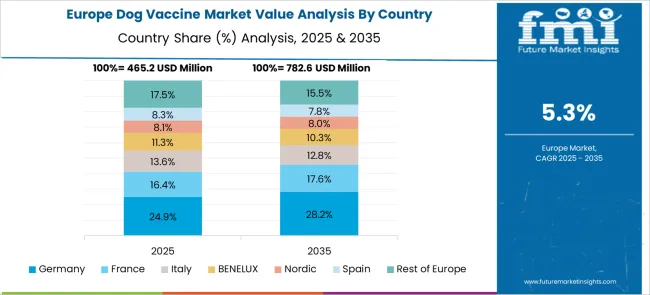
The dog vaccine market in France is expected to grow at a CAGR of 6.1%. France has a well-established pet healthcare market, and the increasing focus on pet wellness is driving the demand for dog vaccines. Pet owners are becoming more conscious of the importance of preventive healthcare, resulting in greater adoption of vaccines. France’s strong veterinary services sector, along with growing awareness around pet diseases and vaccinations, is contributing to the expansion of the dog vaccine market. Additionally, France’s regulatory framework for animal health ensures that pet vaccines meet the highest standards, further driving market demand.
The dog vaccine market in the United Kingdom is projected to grow at a CAGR of 5.5%. The UK has a highly developed pet care industry, with pet healthcare becoming a priority for many owners. The demand for dog vaccines is supported by the increasing awareness of the risks associated with preventable diseases and the availability of quality veterinary services. As more pet owners opt for regular checkups and vaccinations for their dogs, the market for dog vaccines is steadily growing. However, growth in the UK is relatively slower compared to emerging markets due to market maturity and saturation.
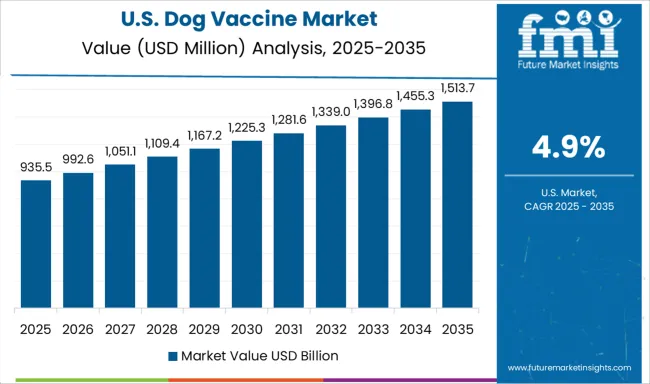
The dog vaccine market in the United States is expected to grow at a CAGR of 4.9%. The USA has a mature pet healthcare market, and the demand for dog vaccines continues to rise as pet owners increasingly prioritize preventive care for their pets. Despite slower growth compared to emerging markets, the USA remains a significant market due to its large pet population and widespread access to veterinary services. Increased awareness of vaccine-preventable diseases, along with a growing focus on pet health and wellness, is expected to support the steady growth of the dog vaccine market in the USA

The dog vaccine market is dominated by Zoetis Inc., which leads with its broad range of high-quality vaccines for preventing common diseases in dogs, including rabies, distemper, and parvovirus. Zoetis' dominance is supported by its strong R&D capabilities, extensive distribution network, and partnerships with veterinarians and animal health professionals.
Key players such as Boehringer Ingelheim International GmbH, Elanco Animal Health Incorporated, and Merck & Co., Inc. maintain significant market shares by offering vaccines that cater to both essential and non-core diseases, ensuring broad protection for pets.
These companies focus on providing safe, effective, and easily administered vaccines that enhance the health and well-being of dogs. Emerging players like Bioveta, a.s., Brilliant Bio Pharma, Creative Biolabs, NEOTECH, LLC, and Virbac are expanding their market presence by offering innovative vaccine solutions that address unmet needs in canine health. Their strategies include developing vaccines for new and emerging diseases, improving vaccine formulations for longer-lasting immunity, and focusing on cost-effective production for wider accessibility.
Market growth is driven by increasing pet ownership, rising awareness of pet health, and the growing demand for preventive care in the animal health industry. Innovations in DNA-based vaccines, combination vaccines, and faster production methods are expected to further shape competitive dynamics and foster continued growth in the dog vaccine market.
| Item | Value |
|---|---|
| Quantitative Units | USD 2.0 Billion |
| Vaccine Type | Live attenuated, Inactivated, Recombinant, and Other vaccine types |
| Disease Type | Canine distemper, Canine infectious respiratory disease complex (CIRDC), Canine parvovirus, Canine leptospirosis, Canine lyme disease, Infectious canine hepatitis, Canine rabies, and Other disease types |
| Route of Administration | Injectable, Intranasal, and Oral |
| End-use | Veterinary hospitals, Veterinary clinics, and Research institutes |
| Regions Covered | North America, Europe, Asia-Pacific, Latin America, Middle East & Africa |
| Country Covered | United States, Canada, Germany, France, United Kingdom, China, Japan, India, Brazil, South Africa |
| Key Companies Profiled | Zoetis Inc., Bioveta, a.s., Boehringer Ingelheim International GmbH, Brilliant Bio Pharma, Creative Biolabs, Elanco Animal Health Incorporated, Merck & Co., Inc., NEOTECH, LLC, Virbac, and Zendal Group |
| Additional Attributes | Dollar sales by vaccine type and application, demand dynamics across veterinary clinics, animal shelters, and pet owners, regional trends in dog vaccine adoption, innovation in vaccine formulations and delivery systems, impact of regulatory standards on pet health and safety, and emerging use cases in preventative care and zoonotic disease control. |
The global dog vaccine market is estimated to be valued at USD 2.0 billion in 2025.
The market size for the dog vaccine market is projected to reach USD 3.5 billion by 2035.
The dog vaccine market is expected to grow at a 5.8% CAGR between 2025 and 2035.
The key product types in dog vaccine market are live attenuated, inactivated, recombinant and other vaccine types.
In terms of disease type, canine distemper segment to command 28.7% share in the dog vaccine market in 2025.






Our Research Products

The "Full Research Suite" delivers actionable market intel, deep dives on markets or technologies, so clients act faster, cut risk, and unlock growth.

The Leaderboard benchmarks and ranks top vendors, classifying them as Established Leaders, Leading Challengers, or Disruptors & Challengers.

Locates where complements amplify value and substitutes erode it, forecasting net impact by horizon

We deliver granular, decision-grade intel: market sizing, 5-year forecasts, pricing, adoption, usage, revenue, and operational KPIs—plus competitor tracking, regulation, and value chains—across 60 countries broadly.

Spot the shifts before they hit your P&L. We track inflection points, adoption curves, pricing moves, and ecosystem plays to show where demand is heading, why it is changing, and what to do next across high-growth markets and disruptive tech

Real-time reads of user behavior. We track shifting priorities, perceptions of today’s and next-gen services, and provider experience, then pace how fast tech moves from trial to adoption, blending buyer, consumer, and channel inputs with social signals (#WhySwitch, #UX).

Partner with our analyst team to build a custom report designed around your business priorities. From analysing market trends to assessing competitors or crafting bespoke datasets, we tailor insights to your needs.
Supplier Intelligence
Discovery & Profiling
Capacity & Footprint
Performance & Risk
Compliance & Governance
Commercial Readiness
Who Supplies Whom
Scorecards & Shortlists
Playbooks & Docs
Category Intelligence
Definition & Scope
Demand & Use Cases
Cost Drivers
Market Structure
Supply Chain Map
Trade & Policy
Operating Norms
Deliverables
Buyer Intelligence
Account Basics
Spend & Scope
Procurement Model
Vendor Requirements
Terms & Policies
Entry Strategy
Pain Points & Triggers
Outputs
Pricing Analysis
Benchmarks
Trends
Should-Cost
Indexation
Landed Cost
Commercial Terms
Deliverables
Brand Analysis
Positioning & Value Prop
Share & Presence
Customer Evidence
Go-to-Market
Digital & Reputation
Compliance & Trust
KPIs & Gaps
Outputs
Full Research Suite comprises of:
Market outlook & trends analysis
Interviews & case studies
Strategic recommendations
Vendor profiles & capabilities analysis
5-year forecasts
8 regions and 60+ country-level data splits
Market segment data splits
12 months of continuous data updates
DELIVERED AS:
PDF EXCEL ONLINE
Vaccine Preservatives Market Analysis - Size, Share, and Forecast Outlook 2025 to 2035
Vaccine Stabilizers Market Analysis - Size, Share, and Forecast Outlook 2025 to 2035
Dog Treat Launcher Market Size and Share Forecast Outlook 2025 to 2035
Dog Footwear Market Size and Share Forecast Outlook 2025 to 2035
Dog Training Equipment Market Size and Share Forecast Outlook 2025 to 2035
Dog Food Market Analysis - Size, Share, and Forecast 2025 to 2035
Dog Intestinal Health Pet Dietary Supplement Market Size and Share Forecast Outlook 2025 to 2035
Dog Food and Snacks Market Size and Share Forecast Outlook 2025 to 2035
Dog Float Market Size and Share Forecast Outlook 2025 to 2035
Vaccine Vial Rubber Stopper Market Size and Share Forecast Outlook 2025 to 2035
Vaccine Transport Carrier Market Size and Share Forecast Outlook 2025 to 2035
Vaccine Shippers Market Size and Share Forecast Outlook 2025 to 2035
Vaccines Market Insights - Trends, Growth & Forecast 2025 to 2035
Dog Gates, Doors, & Pens Market Analysis - Trends, Growth & Forecast 2025 to 2035
Dog Collars Market Analysis - Trends, Growth & Forecast 2025 to 2035
Dog Safety Leash Market Analysis - Trends, Growth & Forecast 2025 to 2035
Dog Dental Chews Market Analysis by Product Type, Age, Flavor, Application and Sales Channel Through 2035
Dog Collars, Leashes & Harnesses Market Analysis by Dog Collars, Dog Leash, Dog Harness, Material Type, Distribution Channel and Region Through 2025 to 2035.
Competitive Overview of Dog Gates, Doors and Pens Companies
Vaccine Packaging Market Growth - Demand & Forecast 2024 to 2034

Thank you!
You will receive an email from our Business Development Manager. Please be sure to check your SPAM/JUNK folder too.
Chat With
MaRIA